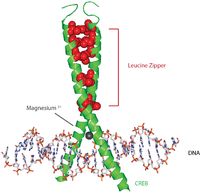CREB

CREB-TF (CREB, cAMP response element-binding protein)
Genes whose transcription is regulated by CREB include:
CREB is closely related in structure and function to
CREB has a well-documented role in neuronal plasticity and long-term memory formation in the brain and has been shown to be integral in the formation of spatial memory.[5] CREB downregulation is implicated in the pathology of Alzheimer's disease and increasing the expression of CREB is being considered as a possible therapeutic target for Alzheimer's disease.[6] CREB also has a role in photoentrainment in mammals.
Subtypes
The following genes encode CREB or CREB-like proteins:
- CREB1 (CREB1)
- CREB2 renamed ATF4 (ATF4)
- CREB3 (CREB3)
- CREB5 (CREB5)
- CREB3L1 (CREB3L1)
- CREB3L2 (CREB3L2)
- CREB3L3 (CREB3L3)
- CREB3L4 (CREB3L4)
Structure

CREB proteins are activated by phosphorylation from various kinases, including PKA, and Ca2+/calmodulin-dependent protein kinases on the Serine 133 residue.[7] When activated, CREB protein recruits other transcriptional coactivators to bind to CRE promoter 5’ upstream region. Hydrophobic leucine amino acids are located along the inner edge of the alpha helix. These leucine residues tightly bind to leucine residues of another CREB protein forming a dimer. This chain of leucine residues forms the leucine zipper motif. The protein also has a magnesium ion that facilitates binding to DNA.
cAMP response element
The cAMP response element (CRE) is the response element for CREB which contains the highly conserved nucleotide sequence, 5'-TGACGTCA-3’. CRE sites are typically found upstream of genes, within the promoter or enhancer regions.[8] There are approximately 750,000 palindromic and half-site CREs in the human genome. However, the majority of these sites remain unbound due to cytosine methylation, which physically obstructs protein binding.[9]
Mechanism of action
A generalized sequence of events is summarized as follows: A signal arrives at the cell surface, activates the corresponding receptor, which leads to the production of a
Function in the brain
CREB has many functions in many different organs, and some of its functions have been studied in relation to the brain. There are activator and repressor forms of CREB. Flies genetically engineered to overexpress the inactive form of CREB lose their ability to retain long-term memory. CREB is also important for the survival of neurons, as shown in genetically engineered mice, where CREB and CREM were deleted in the brain. If CREB is lost in the whole developing mouse embryo, the mice die immediately after birth, again highlighting the critical role of CREB in promoting neuronal survival.
Disease linkage
Disturbance of CREB function in the brain can contribute to the development and progression of Huntington's disease.
Abnormalities of a protein that interacts with the KID domain of CREB, the
There is some evidence to suggest that the under-functioning of CREB is associated with
CREB is also thought to be involved in the growth of some types of cancer.
Involvement in circadian rhythms
Discovery of CREB involvement in circadian rhythms
Michael Greenberg first demonstrated the role of CREB in the mammalian circadian clock in 1993 through a series of experiments that correlated phase-specific light pulses with CREB phosphorylation. In vitro, light during the subjective night increased phosphorylation of CREB rather than CREB protein levels. In vivo, phase shift-inducing light pulses during the subjective night correlated with CREB phosphorylation in the SCN.[20] Experiments by Gunther Schutz in 2002 demonstrated that mutant mice lacking the Ser142 phosphorylation site failed to induce the clock regulatory gene mPer1 in response to a light pulse. Furthermore, these mutant mice had difficulty entraining to light-dark cycles.[21]
See also
References
- ^ S2CID 17250247.
- ^ ISBN 978-0-87893-697-7.
- S2CID 4345292.
- ^ PMID 20148687.
- PMID 9530494. Archived from the original(PDF) on 28 August 2008. Retrieved 22 January 2010.
- ^ Downregulation of CREB expression in Alzheimer's brain and in Ab-treated rat hippocampal neurons
- PMID 10872467.
- S2CID 6480593.
- PMID 21346730.
- PMID 28733084.
- S2CID 6480593.
- PMID 22583753.
- S2CID 24064950.
- PMID 19243452.
- PMID 19244515.
- ^ PMID 18172175.
- ^ S2CID 20918484.
- PMID 25285070.
- PMID 10364217.
- PMID 8097062.
- S2CID 14507897.
- Bibliography
- Lauren Slater (2005). Opening Skinner's Box: Great Psychological Experiments of the Twentieth Century. New York: W. W. Norton & Company. ISBN 978-0-393-32655-0.
- Barco A, Bailey C, Kandel E (2006). "Common molecular mechanisms in explicit and implicit memory". J. Neurochem. 97 (6): 1520–33. PMID 16805766.
- Conkright M, Montminy M (2005). "CREB: the unindicted cancer co-conspirator". Trends Cell Biol. 15 (9): 457–9. PMID 16084096.
- Mantamadiotis T, Lemberger T, Bleckmann S, Kern H, Kretz O, Martin Villalba A, Tronche F, Kellendonk C, Gau D, Kapfhammer J, Otto C, Schmid W, Schütz G (2002). "Disruption of CREB function in brain leads to neurodegeneration". Nat. Genet. 31 (1): 47–54. S2CID 22014116.
- Mayr B, Montminy M (2001). "Transcriptional regulation by the phosphorylation-dependent factor CREB". Nat. Rev. Mol. Cell Biol. 2 (8): 599–609. S2CID 1056720.
- Yin J, Del Vecchio M, Zhou H, Tully T (1995). "CREB as a memory modulator: induced expression of a dCREB2 activator isoform enhances long-term memory in Drosophila". Cell. 81 (1): 107–15. S2CID 15863948.
- Yin J, Wallach J, Del Vecchio M, Wilder E, Zhou H, Quinn W, Tully T (1994). "Induction of a dominant negative CREB transgene specifically blocks long-term memory in Drosophila". Cell. 79 (1): 49–58. S2CID 33623585.
External links
- http://www.ebi.ac.uk/interpro/entry/IPR001630
- Johannessen, M., Pedersen Delghandi, M., and Moens, U. (2004) - What Turns CREB on ? - Cell Signall.; 10:1211-1227. https://web.archive.org/web/20070928090058/http://www.sigtrans.org/publications/what-turns-creb-on/
- https://web.archive.org/web/20060902183214/http://focus.hms.harvard.edu//2001/Oct26_2001/neuroscience.html
- CREB+Protein at the U.S. National Library of Medicine Medical Subject Headings (MeSH)
- Drosophila Cyclic-AMP response element binding protein A - The Interactive Fly
- Drosophila Cyclic-AMP response element binding protein B at 17A - The Interactive Fly
